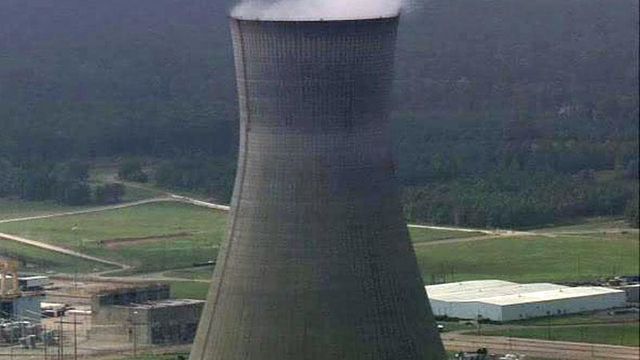Spent nuclear fuel stored at Wake County plant
According to data provided to the Nuclear Energy Institute, North Carolina is home to the fifth largest store of spent nuclear fuel in the nation, with almost 3,800 tons.
Posted — UpdatedProgress Energy, the Raleigh-based utility that owns Shearon Harris, however, says nuclear facilities provide safe, reliable, cost-effective and clean energy for a growing number of customers. Twenty percent of North Carolina’s electricity comes from nuclear generation. President Obama said Wednesday that nuclear power will play an important role in the country’s future energy policy.
North Carolina is home to five nuclear reactors – two, owned by Duke Energy, are located near Charlotte. Progress Energy owns three – Shearon Harris and two in Southport, near the coast.
The Harris plant’s 526-foot cooling tower is a visible landmark in the area, but opponents to Progress Energy’s proposal to build two new reactors at the site are concerned about what is lurking unseen at the plant.
They raise concerns about the large amounts of radioactive waste stored at the plant. Progress Energy, however, points to the plant’s safety track record and the lack of other viable options for spent fuel storage.
The future of nuclear power in North Carolina is uncertain, but the ripples from Japan’s crisis are stretching far around the globe and will pose challenges for the credibility and success of the nuclear industry for years.
Nuclear plant presence could grow with Wake County
The Shearon Harris nuclear plant, built in 1987 in the then-rural southwest corner of Wake County, near New Hill, is an impressive sight. Built with 24 million pounds of reinforced steel and enough concrete to construct a four-lane highway from Raleigh to Greensboro, it is Progress Energy’s newest nuclear reactor.
It can provide power to more than a half million homes and businesses.
Mike Hughes, a spokesman for Progress Energy, said the plant was built with natural disasters in mind, though the chances for an earthquake or tsunami in the Carolinas are slim.
Reactor 1, as it’s called, is protected from earthquakes, tornadoes, hurricanes and “man-made issues such as terrorist acts,” Hughes said.
In the 24 years since the plant was built, the population in Wake County has exploded. About 55,000 people now live within 10 miles of the plant and more than two million live in a 50-mile range.
The plant is looking to grow as well.
The application has not yet been approved and construction could take years, but opponents are already sounding the warning about what more nuclear reactors could mean for the area.
Environment North Carolina, a research and advocacy group based in Raleigh that aims to protect the state’s air, water and open spaces, is calling for more investigation into the storage of spent fuel before proceeding with new reactor construction.
“We shouldn’t be considering new nuclear reactors at Shearon Harris,” said Environment North Carolina’s director, Elizabeth Ouzts. “The nuclear power is just not worth the risk."
According to data provided to the Nuclear Energy Institute, North Carolina is home to the fifth largest store of spent nuclear fuel in the nation, with almost 3,800 tons. Only Illinois, South Carolina, Pennsylvania and New York have more spent fuel stored within their borders.
It’s not clear how much of that waste is actually at Shearon Harris, but until 2008, Progress Energy shipped in spent fuel from three of its other reactors to Shearon Harris’ cooling pools.
“One reason the Shearon Harris plant is such a concern is that it is said to have more spent fuel rods than any other plant in the country contained in cooling pools,” Ouzts said. “That’s a real concern because that’s not the best, safest way to store nuclear waste.”
Spent fuel rods, which are radioactive, are long metal tubes where used uranium material is stored after the nuclear fission process is complete. That process is what creates nuclear energy.
After the fission process, the used uranium material must be cooled and stored.
The Harris plant is equipped with four cooling pools where rods are kept under at least 20 feet of water. Three are in use. If their expansion proposal is approved, the plant will have to come up with additional storage for spent fuel, Hughes said.
He added that the federal government promised to build a safe storage area for spent fuel in Nevada’s Yucca Mountain in 1998.
That never happened.
“The federal government is 13 years in arrears on fulfilling that contract,” Hughes said.
Still, Hughes said Harris has more than adequate safe storage for the life of the existing plant.
But nuclear opponents point to federal Nuclear Regulatory Commission records that show the plant has been cited five times for safety-related violations since 1998.
“It’s been a very, very safe plant,” he said.
Japan’s problems are far away, but lessons hit close to home
Though the risk of a catastrophic earthquake like the one that rocked Japan and sent a tsunami cascading onshore, killing an estimated 18,000 people and wiping out entire villages, is quite low, Hughes said it puts the nuclear industry in the spotlight.
“We’re always under the microscope in the nuclear industry. That’s to be expected,” Hughes said. “The microscope is quite refined and very focused these days.”
The most serious earthquake recorded in the Carolinas rocked Charleston, South Carolina, in 1886.
State geologist Ken Taylor said the likelihood of a high-magnitude quake near the Harris plant to release radioactive material into neighboring communities isn’t even on the radar.
“There are fault lines out there, but these fault lines haven’t moved in millions and millions of years,” Taylor said.
• Credits
Copyright 2024 by Capitol Broadcasting Company. All rights reserved. This material may not be published, broadcast, rewritten or redistributed.





